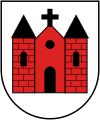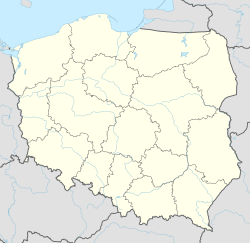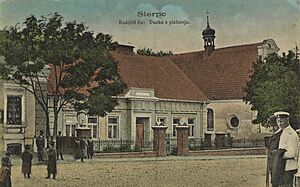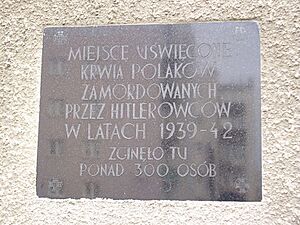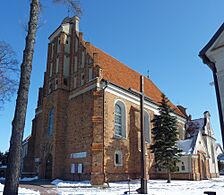Sierpc facts for kids
Quick facts for kids
Sierpc
|
|||
|---|---|---|---|
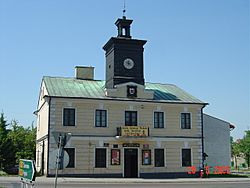
Old town hall
|
|||
|
|||
| Country | |||
| Voivodeship | Masovian | ||
| County | Sierpc | ||
| Gmina | Sierpc (urban gmina) | ||
| Established | 10th century | ||
| Town rights | 1322 | ||
| Area | |||
| • Total | 18.6 km2 (7.2 sq mi) | ||
| Population
(2010)
|
|||
| • Total | 18,368 | ||
| • Density | 987.5/km2 (2,558/sq mi) | ||
| Time zone | UTC+1 (CET) | ||
| • Summer (DST) | UTC+2 (CEST) | ||
| Postal code |
09-200
|
||
| Area code(s) | +48 024 | ||
| Vehicle registration | WSE | ||
| Website | http://www.sierpc.pl | ||
Sierpc is a town in north-central Poland. It is located in the north-west part of the Masovian Voivodeship, about 125 kilometers northwest of Warsaw. Sierpc is the main town of Sierpc County. In 2010, its population was 18,368 people.
Sierpc is also a member of Cittaslow, which is a network of towns that aim to improve the quality of life for their residents.
Contents
History of Sierpc
Sierpc has a long history, dating back to the 10th century. At that time, it was a stronghold (a fortified settlement) in early Poland, ruled by the Piast dynasty. People believe a church was built here as early as 1003. The first time Sierpc was mentioned in writing was in 1155.
In 1322, Sierpc gained town rights, which meant it could govern itself more independently. The town was owned by the bishops of Płock. The name "Sierpc" comes from Polish words, possibly "sierp" (meaning "sickle") or from old Polish names.
In 1509, the Polish King Sigismund I the Old gave a special "protective make" to cloth makers in Sierpc. This was a mark of quality and importance for the town's products. Sierpc was part of the Płock Voivodeship within the Greater Poland Province. In the 1600s, there was even a notable Scottish community living in Sierpc.
Changes and Challenges
In 1793, Sierpc began to decline when it was taken over by Prussia during the Partitions of Poland. However, in 1807, it became part of the Duchy of Warsaw, a Polish state created by Napoleon. In 1815, it joined Congress Poland, which was later controlled by the Russian Empire.
After a Polish uprising against Russia in 1831, Sierpc was damaged by fighting and a plague. But it slowly started to recover. In 1863, during another Polish uprising, the town was briefly captured by Polish fighters before being taken back by the Russians. In 1867, Sierpc became a district town again, leading to a period of quick economic growth. After World War I in 1918, Poland became independent, and Sierpc was once again part of Poland.
During the Polish–Soviet War in 1920, Soviet forces captured Sierpc for a few days, causing damage and looting. In 1921, Sierpc had a population of 6,722 people, with 2,861 (about 42.5%) being Jewish.
World War II in Sierpc
From 1939 to 1945, during World War II, Sierpc was under German occupation. The Germans changed the town's name to Sichelberg to remove its Polish identity. They set up a prison for Poles in the town. Sadly, many disabled people from the area were killed by the Germans in a nearby forest in March 1940.
On April 5, 1940, the Germans arrested about 600 Polish people from the town and county, putting them in local prisons. A local priest, Bronisław Kolator, was one of many Polish priests who died in a concentration camp. About 2,000 Poles were forced to leave Sierpc in February 1940, and another 400 in December 1940. They were sent to a concentration camp and then to another part of German-occupied Poland. Their homes and workshops were given to German settlers as part of a plan to expand German territory. A forced labor camp was also operated in the town.
The German occupation also brought terrible suffering to the Jewish community in Sierpc. In November 1939, Jewish residents were forced into special areas called ghettos and later sent to Nazi concentration camps. Sadly, about five thousand Jewish people from Sierpc and nearby areas lost their lives during the Holocaust. After the war, Jewish people who survived from Sierpc shared their stories about life before the war and the terrible things that happened during the Holocaust.
Places to Visit in Sierpc
The Museum of the Countryside
This is an open-air museum located just outside Sierpc, in the valley of the Sierpienica River. It's very large, covering about 60.5 hectares, and looks like a separate village. The museum has 11 old farms, an inn, a blacksmith's workshop, an oil mill, a windmill, a manor house, a small chapel, and a wooden church. All these buildings were brought from different parts of the Masovia region.
The houses are built in the style of the 19th or early 20th century. Inside, you can see furniture, tools, and decorations from that time. The museum often has special exhibitions about traditional Masovian customs, like "Christmas in Mazovie Region" or "Easter in Mazovie Region." There are also fun events for children, such as "Palm Sunday in Skansen museum" or "Children's Day in Skansen museum."
Several movies have been filmed at this museum, including famous Polish films like Pan Tadeusz and Ogniem i mieczem.
The Holy Spirit Church
This church was built in the 16th century. It started as a chapel next to a hospital. The church was first built in the Gothic style and later rebuilt in the Baroque style. A fire in the 17th century badly damaged the church, and after it was rebuilt again, it changed its original look.
The most valuable treasures in the church are old paintings from the Middle Ages and a sculpture from the 16th century called "Generosity's Throne." This sculpture was made by students of the famous artist Veit Stoss and is now in the main altar.
"Kasztelanka" Manor House
The "Kasztelanka" manor house was built around the late 1600s or early 1700s. It is one of the most important old buildings in the Sierpc area and the oldest non-religious building in the town. It is a timber house with a thatched roof.
There are many mysterious legends and stories about "Kasztelanka" and the Benedictine monastery next to it. The monastery is connected to the manor house by a corridor. It looks much stronger and more solid, suggesting it might have been built to defend against attacks, perhaps from the Swedish army.
Population of Sierpc
| Historical population | ||
|---|---|---|
| Year | Pop. | ±% |
| 1897 | 8,634 | — |
| 1910 | 8,001 | −7.3% |
| 1921 | 6,722 | −16.0% |
| 1931 | 10,051 | +49.5% |
| 1939 | 13,000 | +29.3% |
| 1950 | 9,324 | −28.3% |
| 1960 | 10,931 | +17.2% |
| 2010 | 18,368 | +68.0% |
The population of Sierpc has changed over the years. In 1897, there were 8,634 people, and by 2010, the population had grown to 18,368.
Transportation in Sierpc
Sierpc is located where several important roads meet. National road No 10 connects Warsaw and Toruń and passes through Sierpc. There are also voivodeship roads No 541 and 560. Sierpc is also a railway hub, with two train lines crossing here: one from Kutno to Brodnica and another from Nasielsk to Toruń.
Economy of Sierpc
The town is home to the Kasztelan brewery, which is a local business.
Asteroid named after Sierpc
Did you know that an asteroid is named after Sierpc? The 199950 Sierpc asteroid was given its name in honor of the town.
Notable People from Sierpc
- Zbigniew Girzyński (born 1973), a politician.
- Anna Jagodzinska (born 1987), a model.
See also
 In Spanish: Sierpc para niños
In Spanish: Sierpc para niños



